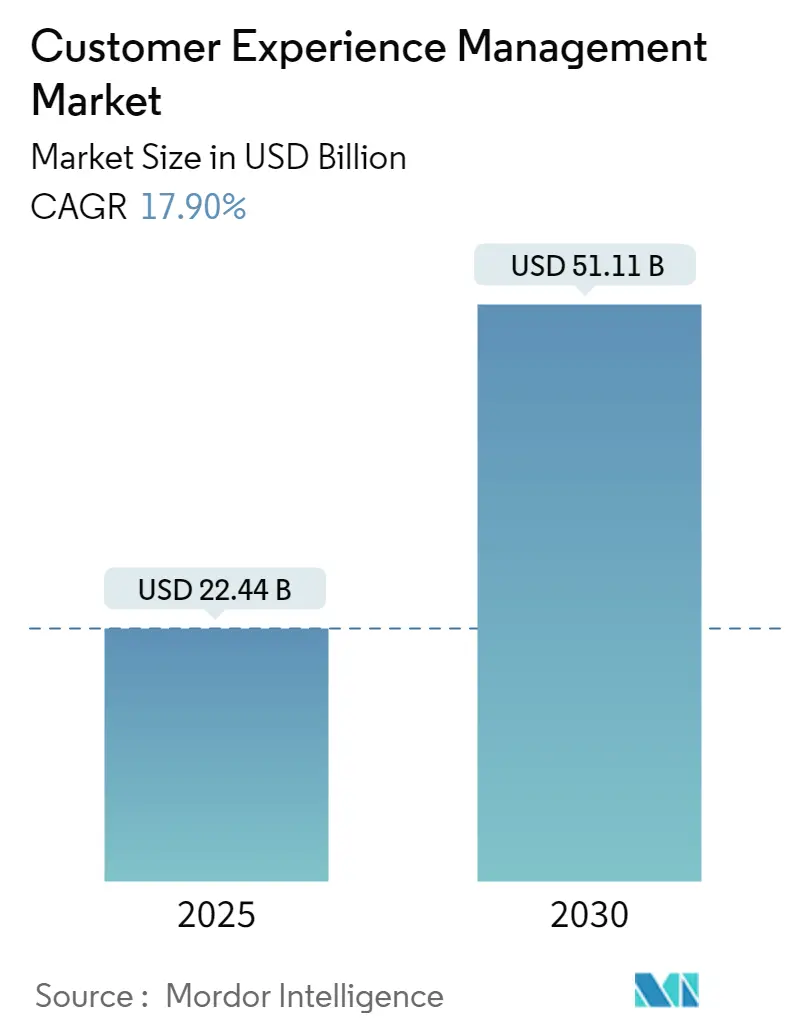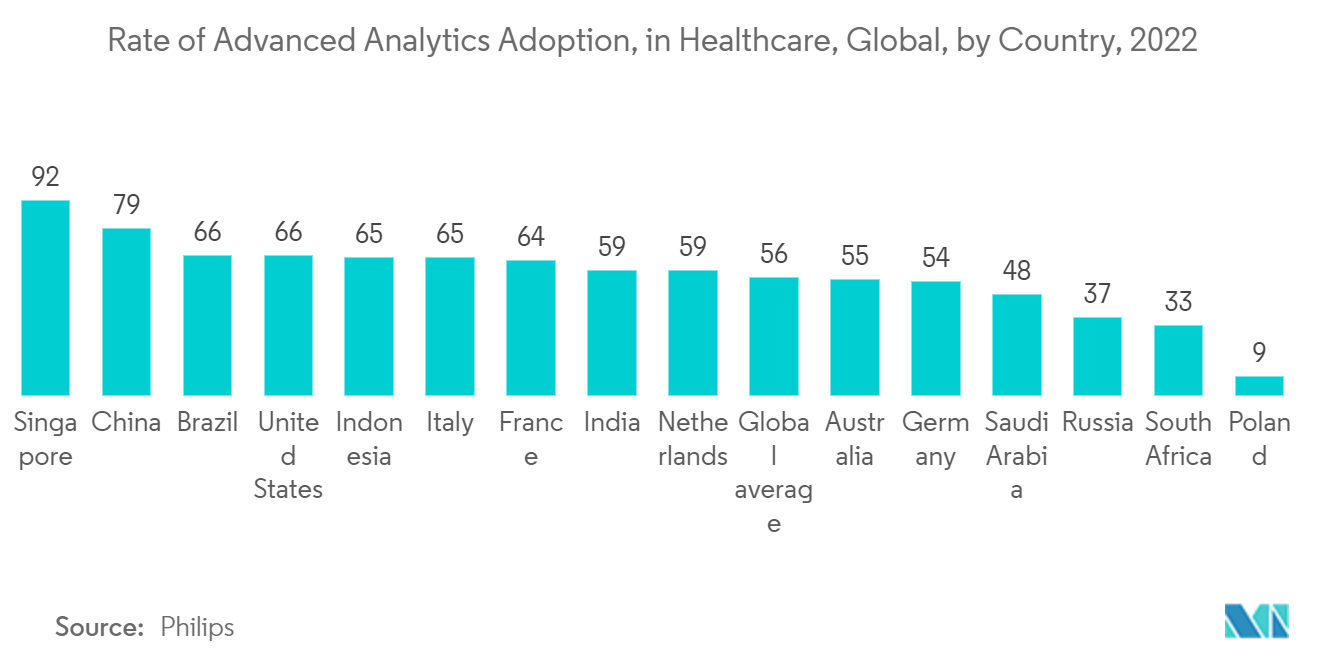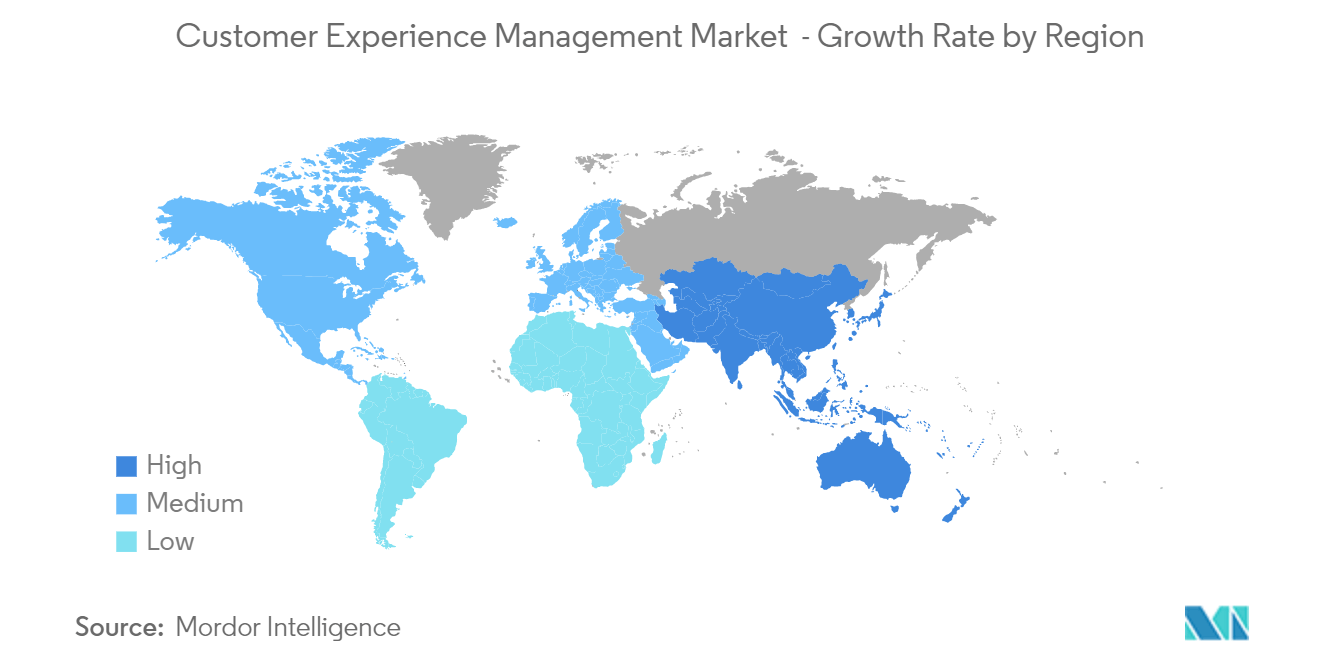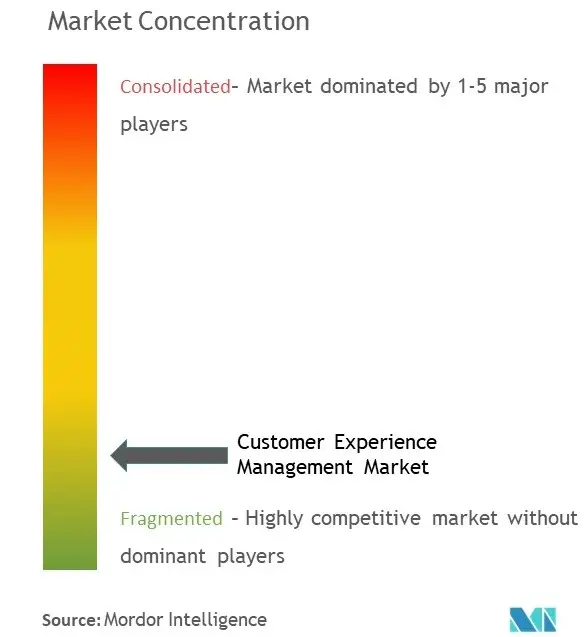Customer Experience Management Market Size and Share

Customer Experience Management Market Analysis by Mordor Intelligence
The Customer Experience Management Market size is estimated at USD 22.44 billion in 2025, and is expected to reach USD 51.11 billion by 2030, at a CAGR of 17.9% during the forecast period (2025-2030).
Increasing adoption of digitalization, technological advancements in cloud and artificial intelligence solutions, rapid integration of multichannel touchpoints into a single platform, and the increasing need to analyze customer data to draw business insights to increase revenue are some primary factors boosting the customer experience management market.
- Brands increasingly depend on customer experience management tools to determine customers' requirements and verify that the customer needs and the company's offerings are on the same level to be one step ahead of competitors. Companies also utilize cloud-based technology, advanced analytics, and automation to provide highly personalized customer experience and build brand loyalty to reduce churn rate.
- The advent of technology has led to the digitalization of every sector and has tremendously increased digital customer interaction. Technology evolution at a rapid pace has led to the creation of more intuitive and user-friendly interactions. But as customers are now accustomed to user-friendly and personalized digital natives, such as Google and Amazon, they expect the same kind of service from established players. According to research, 25% of customers will deflect after just one bad experience, and thus, companies are demanding multi-purpose, user-friendly, accurate, and fast solutions from key vendors.
- The increasing usage of AI and AR is expected to create significant growth opportunities for the market, as AI and AR can accomplish task automation and self-service responses. Furthermore, sophisticated AI applications like digital assistants, chatbots, biometric measurements, and facial recognition boost user experience and revenue. The increasing usage of sophisticated AI and AR technologies is expected to drive market development.
- Moreover, consumer behavior has changed during this period. As various industries struggle with the situation, enterprises focus on customer loyalty, retention, and engagement. Organizations found a need to identify customers' weak points and develop innovative ways to cater to changing business expectations.
- Customers are turning to self-service tools in the form of chats, messaging, and conversational bots. As a result, companies are required to enable these tools to deliver great customer experience while reducing traditional dependencies on brick-and-mortar and live events, which were not feasible in a time of social distancing during the Pandemic.
Global Customer Experience Management Market Trends and Insights
Rapid Adoption of Cloud-based Technology, Advanced Analytics, and Automation
- The customer experience management software captures feedback from every customer interaction, analyzes them, and aids various organization teams in understanding emerging trends and customer issues. It enables companies to monitor, respond, and improve every key moment along the customer journey. The increasing usage of artificial intelligence, Cloud, advanced analytics, and automation in industries such as retail, IT and telecom, transportation, BFSI, and health, among others, improves customer experience solutions and assists in forecasting future consumer behavior. AI-enabled predictive analytics and solutions help extract useful insights from consumer data. As a result, organizations focus on using advanced technology to improve the customer experience.
- The rapid adoption of mobile and access to internet services across the globe has forced all end-user companies to switch to mobile-supporting applications to enhance the customer experience. Modern travelers use technology at every point, from reaching the airport, checking in, accessing in-flight entertainment, managing itineraries, unlocking hotel rooms, handling customer service problems, or looking for food to eat. This trend has led to the development of mobile integration solutions that provide personalized data and ultimately improve customer experience. For instance, Wyndham Hotel Group uses Adobe Analytics to gather data, time-based metrics, geolocation, and personalization data for a better application experience for loyalty members.
- Emerging technologies like the release of 5G, advancements in Artificial Intelligence, and improved voice search are some technological disruptions that will create new ways for travel companies to engage customers and make travel easier and more convenient. For instance, travel companies use messaging apps and chatbots to integrate the growing power of artificial intelligence into the mobile travel experience.
- Organizations are adopting business analytics tools, such as sentiment analytics, speech analytics, and text analytics. Such efforts are expected to help enterprises understand the insights from unstructured data gathered from customer interactions to provide enhanced digital services.
- The adoption of advanced analytics in various end-user sectors is growing rapidly. According to a survey conducted by Philips, as of February this year, 92 percent of healthcare leaders surveyed in Singapore stated they had already adopted or are implementing predictive analytics in their healthcare business, with the highest adoption rate among all countries examined. China is second with a 79 percent adoption rate, followed by Brazil and the United States at 66 percent.

North America is Expected to Register the Fastest Growth
- North America is expected to hold a prominent share, owing to the growing adoption of customer experience management solutions across various regional industries. Moreover, the region has a strong foothold of vendors, contributing to the market's growth.
- Furthermore, cloud services are essential tools for North American businesses. The cloud is becoming more relevant in growing markets as they provide advanced services to local businesses. They are cost-effective and help organizations to advance technologically.
- The retail sector is investing in CEM tools to improve customer retention. For instance, Walmart Canada plans to invest USD 3.5 billion over the next five years to simplify the online and in-store shopping experience. This investment will lead to an enhanced Omni-experience and the development of modern digital tools to ensure associates better serve customers.
- Moreover, regional enterprises are adopting these solutions primarily to increase their customer service. For instance, one of the largest insurance companies in the United States, MetLife, adopted an AI system primarily to improve responses to its customers' emotional needs. The system was specifically developed to help the company's staff members track and monitor the emotions expressed by customers during conversations, thereby enhancing the quality of customer service interactions.

Competitive Landscape
The customer experience management market is highly competitive and moderately fragmented. Major players like Adobe, Oracle, SAP, IBM, Avaya Inc., and Verint Systems Inc. focus on expanding their customer base across foreign countries. These companies leverage strategic collaborative initiatives to increase their market share and profitability. However, with technological advancements and product innovations, mid-size to smaller companies are growing their market presence by securing new contracts and tapping new markets.
In March 2022, Adobe announced the general availability of Adobe Experience Cloud for Healthcare, a service that enables healthcare businesses to offer their customers customized and secure digital experiences. With Adobe Experience Cloud for Healthcare, providers can provide patients with more options for monitoring their treatment. Consumers can inform healthcare providers about their preferred communication channels, such as getting appointment reminders or care management suggestions by text or email. Providers may then integrate this preference data with other health data to give customers a unified and connected experience, resulting in better treatment and client loyalty.
Customer Experience Management Industry Leaders
-
Adobe Inc
-
Oracle Corporation
-
SAP SE
-
IBM Corporation
-
Avaya Inc.
- *Disclaimer: Major Players sorted in no particular order

Recent Industry Developments
- June 2022 : Kyndryl, a leading global IT infrastructure services provider, has partnered with Oracle to assist customers in speeding their path to the cloud by offering managed cloud solutions to businesses globally. As part of the partnership, Kyndryl would become an Oracle Cloud Infrastructure (OCI) key delivery partner, expanding on its extensive expertise in working with and supporting clients that use Oracle products and services. Customers benefit from security capabilities, consistent high performance, simple, predictable pricing, and the tools and experience required to swiftly and efficiently migrate business workloads to the cloud.
- March 2022: Adobe announced that BMW Group, one of the leading global automotive and motorcycle manufacturers, has expanded its partnership with Adobe as part of its sales and marketing division's digital transformation. BMW Group, which includes BMW, Rolls-Royce, MINI, and BMW Motorrad, is leveraging Adobe Experience Cloud to deliver customized digital experiences as it aims to sell a quarter of all its vehicles online within the next three years. BMW Group will offer consumers seamless online and offline experiences, including customized automobiles, doorstep delivery, and bespoke post-purchase services, using a data-driven, personalized approach.
Global Customer Experience Management Market Report Scope
Customer experience management, abbreviated as CEM or CXM, is a collection of processes an organization utilizes to track, oversee, and organize the interactions between a customer and the company throughout the customer lifecycle. The scope of the study focuses on key regions such as North America, Europe, and Asia-Pacific, in addition to Latin America and Middle East & Africa.
The Customer Experience Management Market is Segmented by Component (Solutions, Services( Professional Services, Managed Services)), by Deployment (Cloud, On-premise), Organization Size (Small and Medium Enterprises (SMEs), Large Enterprises), by Touchpoint (Telephone, Email, Web, Social Media, Other Touchpoints), Application (BFSI, Retail, IT and Telecommunication, Healthcare, Manufacturing, Government, Travel and Transportation), and by Geography (North America, Europe, Asia Pacific, Latin America, and Middle East and Africa).
The market sizes and forecasts are provided in terms of value (USD million) for all the above segments.
| Solutions | |
| Services | Professional Services |
| Managed Services |
| Cloud |
| On-premise |
| Small and Medium Enterprises (SMEs) |
| Large Enterprises |
| Telephone |
| Web |
| Social Media |
| Other Touchpoints |
| BFSI |
| Retail |
| IT and Telecommunication |
| Healthcare |
| Manufacturing |
| Government |
| Travel and Transportation |
| Other Applications |
| North America |
| Europe |
| Asia- Pacific |
| Latin America |
| Middle East & Africa |
| Component | Solutions | |
| Services | Professional Services | |
| Managed Services | ||
| Deployment | Cloud | |
| On-premise | ||
| Organization Size | Small and Medium Enterprises (SMEs) | |
| Large Enterprises | ||
| Touchpoint | Telephone | |
| Web | ||
| Social Media | ||
| Other Touchpoints | ||
| Application | BFSI | |
| Retail | ||
| IT and Telecommunication | ||
| Healthcare | ||
| Manufacturing | ||
| Government | ||
| Travel and Transportation | ||
| Other Applications | ||
| Geography | North America | |
| Europe | ||
| Asia- Pacific | ||
| Latin America | ||
| Middle East & Africa | ||
Key Questions Answered in the Report
How big is the Customer Experience Management Market?
The Customer Experience Management Market size is expected to reach USD 22.44 billion in 2025 and grow at a CAGR of 17.90% to reach USD 51.11 billion by 2030.
What is the current Customer Experience Management Market size?
In 2025, the Customer Experience Management Market size is expected to reach USD 22.44 billion.
Who are the key players in Customer Experience Management Market?
Adobe Inc, Oracle Corporation, SAP SE, IBM Corporation and Avaya Inc. are the major companies operating in the Customer Experience Management Market.
Which is the fastest growing region in Customer Experience Management Market?
Asia Pacific is estimated to grow at the highest CAGR over the forecast period (2025-2030).
Which region has the biggest share in Customer Experience Management Market?
In 2025, the North America accounts for the largest market share in Customer Experience Management Market.
What years does this Customer Experience Management Market cover, and what was the market size in 2024?
In 2024, the Customer Experience Management Market size was estimated at USD 18.42 billion. The report covers the Customer Experience Management Market historical market size for years: 2019, 2020, 2021, 2022, 2023 and 2024. The report also forecasts the Customer Experience Management Market size for years: 2025, 2026, 2027, 2028, 2029 and 2030.
Page last updated on:
Customer Experience Management Market Report
The global customer experience management market is witnessing remarkable growth, driven by increased digitalization and advancements in cloud and AI solutions. Businesses are investing in customer experience management solutions to offer seamless, engaging experiences across multiple touchpoints. The adoption of cloud-based solutions enhances scalability and flexibility, particularly for large enterprises. This growth is reflected in the market analysis and industry analysis, which highlight the significant market size and market share.
The industry outlook is optimistic, with market trends indicating a continued upward trajectory. North America leads this growth due to its advanced technological infrastructure and focus on improving customer interactions. The market forecast suggests that the market value and market growth will continue to rise, supported by a detailed market report and market research.
The use of AI and AR is expected to provide significant growth opportunities, further driving market expansion. Brands are leveraging these tools for customer management and alignment with their offerings. The market segmentation includes various components, deployment models, organization sizes, touchpoints, and applications, contributing to a comprehensive market overview.
Key players in the industry are aiming to expand their customer base globally, as indicated by industry reports and market data. The industry trends show a strong emphasis on personalized interactions and omnichannel strategies. For a comprehensive analysis, the report pdf and industry research offer insights into the market's future direction.
In summary, the customer experience management market is characterized by its dynamic growth rate and market leaders who are setting the pace for innovation. The market review and market predictions underscore the ongoing efforts to forge meaningful customer connections, driving both market size and industry size. The market outlook remains positive, with industry statistics supporting the robust market segmentation and market value. For further details, the report example and research companies provide valuable industry information.



